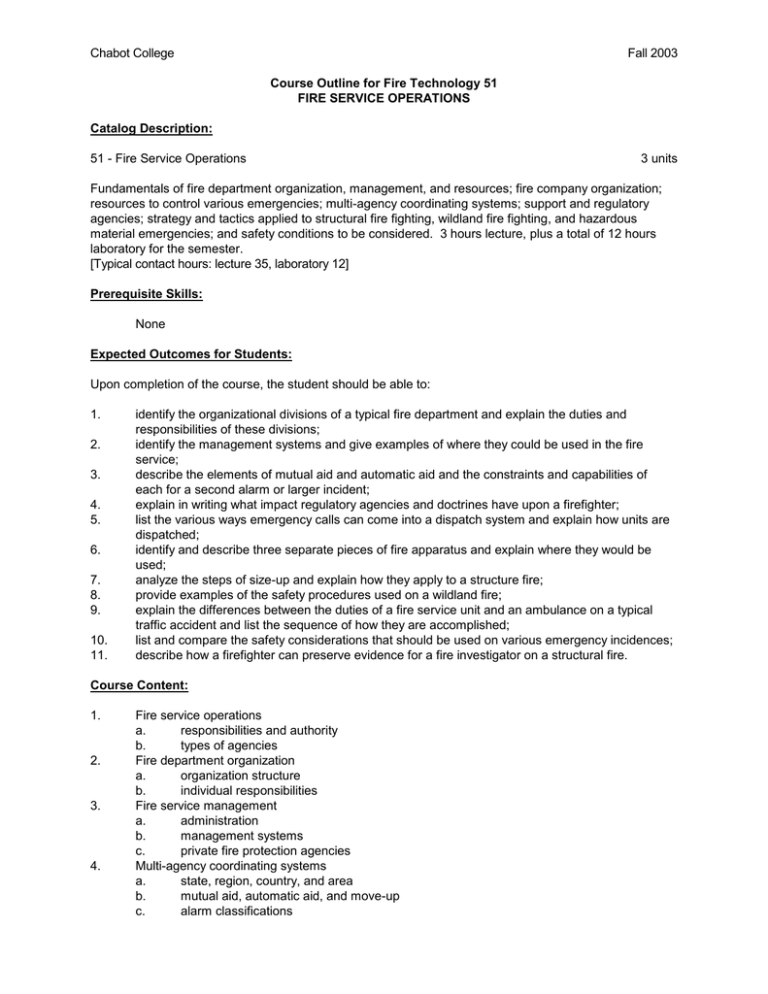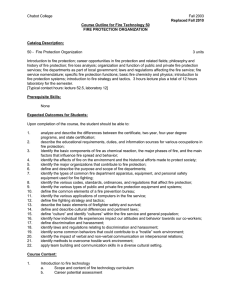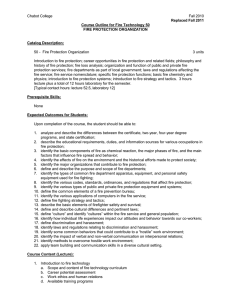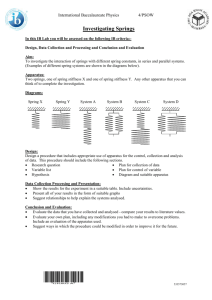Chabot College Fall 2003 51 - Fire Service Operations
advertisement

Chabot College Fall 2003 Course Outline for Fire Technology 51 FIRE SERVICE OPERATIONS Catalog Description: 51 - Fire Service Operations 3 units Fundamentals of fire department organization, management, and resources; fire company organization; resources to control various emergencies; multi-agency coordinating systems; support and regulatory agencies; strategy and tactics applied to structural fire fighting, wildland fire fighting, and hazardous material emergencies; and safety conditions to be considered. 3 hours lecture, plus a total of 12 hours laboratory for the semester. [Typical contact hours: lecture 35, laboratory 12] Prerequisite Skills: None Expected Outcomes for Students: Upon completion of the course, the student should be able to: 1. 2. 3. 4. 5. 6. 7. 8. 9. 10. 11. identify the organizational divisions of a typical fire department and explain the duties and responsibilities of these divisions; identify the management systems and give examples of where they could be used in the fire service; describe the elements of mutual aid and automatic aid and the constraints and capabilities of each for a second alarm or larger incident; explain in writing what impact regulatory agencies and doctrines have upon a firefighter; list the various ways emergency calls can come into a dispatch system and explain how units are dispatched; identify and describe three separate pieces of fire apparatus and explain where they would be used; analyze the steps of size-up and explain how they apply to a structure fire; provide examples of the safety procedures used on a wildland fire; explain the differences between the duties of a fire service unit and an ambulance on a typical traffic accident and list the sequence of how they are accomplished; list and compare the safety considerations that should be used on various emergency incidences; describe how a firefighter can preserve evidence for a fire investigator on a structural fire. Course Content: 1. 2. 3. 4. Fire service operations a. responsibilities and authority b. types of agencies Fire department organization a. organization structure b. individual responsibilities Fire service management a. administration b. management systems c. private fire protection agencies Multi-agency coordinating systems a. state, region, country, and area b. mutual aid, automatic aid, and move-up c. alarm classifications Chabot College Course Outline for Fire Technology 51, page 2 Fall 2003 5. 6. 7. 8. 9. 10. 11. 12. 13. Support and regulatory agencies a. support b. regulatory Dispatch systems a. how calls are received and units dispatched b. local and supervised alarm systems Types of fire department apparatus a. types of engines and their equipment b. ladder trucks and aerial platforms c. aircraft and airport apparatus d. wildland apparatus e. auxiliary apparatus f. EMS apparatus Structural fire fighting a. fire behavior in structures b. building construction hazards c. tactics and strategy d. types of attacks e. supporting fire protection systems f. fireline safety Wildland fire fighting a. fire behavior b. tactics and strategy c. fireline safety Emergency medical services a. types of incidents b. training requirements c. ambulances and squads d. safety Transportation incidents a. roadway b. aircraft c. rail d. marine e. safety Hazardous materials a. classification and identification system b. transportation and pipeline incidents c. handling and storage incidents d. tactics and strategy e. reference texts f. safety Fire investigation responsibilities a. preservation of evidence Methods of Presentation: 1. 2. 3. 4. 5. Lecture and discussion Field trips Audio-visual presentations Group activities Diagnostic quizzes Chabot College Course Outline for Fire Technology 51, page 3 Fall 2003 Typical Assignments and Methods of Evaluating Student Progress: 1. Typical Assignments a. Essay demonstrating a knowledge of the structure and organization of a fire department b. Present a typical fire department for a large size city (greater than 100,000 population) c. In a group list the elements of a size-up for a structure fire 2. Methods of Evaluating Student Progress a. Weekly quizzes b. Course project c. Classroom activities d. Midterm and final examinations Textbook(s) (Typical): IFSTA - Essentials of Fire Fighting, IFSTA , 4th edition, 2001 National Fire Protection Handbook, IFSTA, 19th edition, 2001 Special Student Materials: None Revised: 9/19/02


